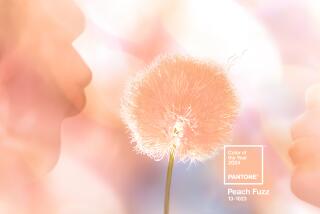Group Selects the Trends That Color Our Lives : Reds, blues and greens are ‘rising brights,’ while blacks, grays waning, experts say.
- Share via
Colors are like fashion. The trends are always in transition--changing, moving up the popularity scale, then receding to be recycled at some later date.
Right now, says Margaret Walch, associate director of the Color Assn. of the United States, we are living in a strong cycle of reds, blues and greens. And we may soon be witnessing the diminution of currently popular grays and blacks.
And 1989 may well be the last hurrah for the blackened-dark palette of saturated colors such as plum purple, black, hunter green, dark berry red and charcoal gray.
But watch out for the “rising brights” that are waiting in the wings to knock our eyes out in the 1990s. These include marigold yellow, orange, hot pink, vibrant violet, jade and emerald green and bright royal blue.
Many of these are also called “ethnic brights,” because they are influenced by the vivid colors of India and the festival colors of Latino communities. These colors will be very clear and very lively, and they will become mainstream in the early 1990s.
If you want to know the “color constants” of the 1980s, they are purple, peach and pink.
Grayed mauves have seen their day, but the more luminous purples such as violet, fuchsia and magenta will come on strong in days to come.
The Color Assn., which is at 343 Lexington Ave., N.Y., has been helping American businesses make the right color decisions for years. It is one of several major color-predicting groups.
Accurate prediction is not an easy job, Walch said, because consumers change their color preferences so frequently.
Feeling (or emotion) is the word the experts use to describe general response to color, and it is the reason given for calling color prediction a “feeling science.”
The predictors contend that no color flies for long unless it is “likable” and “comfortable” by current standards. If a color is too erratic or too aggressive, it may be high fashion, but it is short-lived.
“Colors that people are acutely aware of recede,” Walch said, “because of simple boredom. People just grow tired of them and demand a change, which is why they seldom recover a sofa, or buy a new one, in the same color as the old one.”
What makes color trends?
“They are in the air and you have to catch them,” Walch said. “They are compounded of economics, aesthetics and a sense of timing. They may be inspired by art, history, nature or prevailing consumer moods.
“Leading magazines exert tremendous influence. So are blockbuster museum shows such as ‘The Royal Robes of India’ or the current Degas exhibition at the Metropolitan Museum of Art. The latter will probably promote mid-tone pastels, particularly pink.
“The movie ‘Salaam Bombay’ will encourage more rich ‘ethnic brights’ from India. The movie ‘Out of Africa’ gave a boost to safari-type neutrals such as desert sand, ecru, ivory, olive drab and taupe.”
The delectable flamingo pink and aqua turquoise combination, which the television show “Miami Vice” put on the map in 1983, will be recycled for the 1990s.
The Color Assn. chooses its forecast colors each July, when an 11-member committee of experts from various fields gathers to examine almost 500 colors brought in by the committee members, which include fashion designer Mary McFadden, textile designer Jack Lenor Larsen and interior designer Everett Brown.
It’s their job to weigh and winnow those colors to the 46 forecast colors that will be turning up in both the fashion and interior design fields the coming seasons.
Their narrowed-down choices, arrived at after hours of discussion, will finally be made into color cards and distributed to the 1,500 members of the association. The cards provide color guidance to designers, architects, stylists, manufacturers and retailers.
The right colors sell goods and keep cash registers ringing. When a predicted color bombs, the close-out or end-of-season sales tell the tale.
Distributed by the Los Angeles Times Syndicate.






